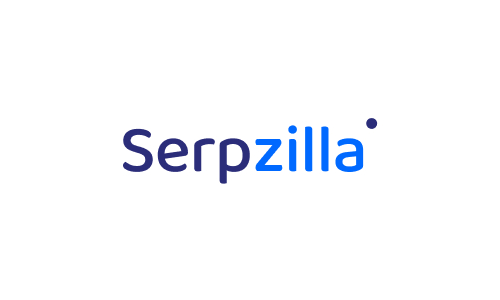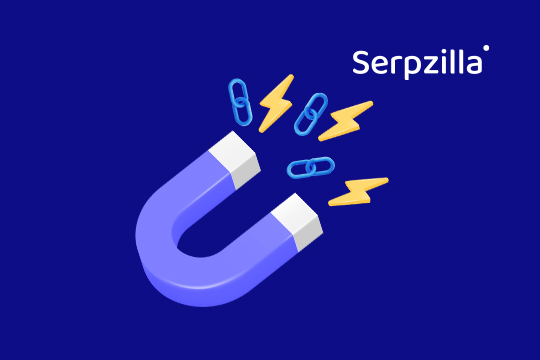Answer Engine Optimization (AEO) is all about this: shaping your content so that AI-powered search tools see it as the answer to user queries.
In 2025, this matters for two big reasons:
- Search is becoming largely conversational. More people are using AI chatbots (ChatGPT, Bing Copilot), voice assistants, and Google’s AI summaries. AEO is how you show up within those experiences and not just in the “10 blue links.”
- Visibility now includes “mentions,” not only ranking. Instead of measuring a page by how high it ranks, AEO rewards content that’s cited or quoted by AI as part of an answer. That’s a new kind of authority.
Answer Engines and AI search tools are clearly on the rise. Following the release of ChatGPT, the global traffic to major search engines decreased. Google’s dropped by almost 8%!
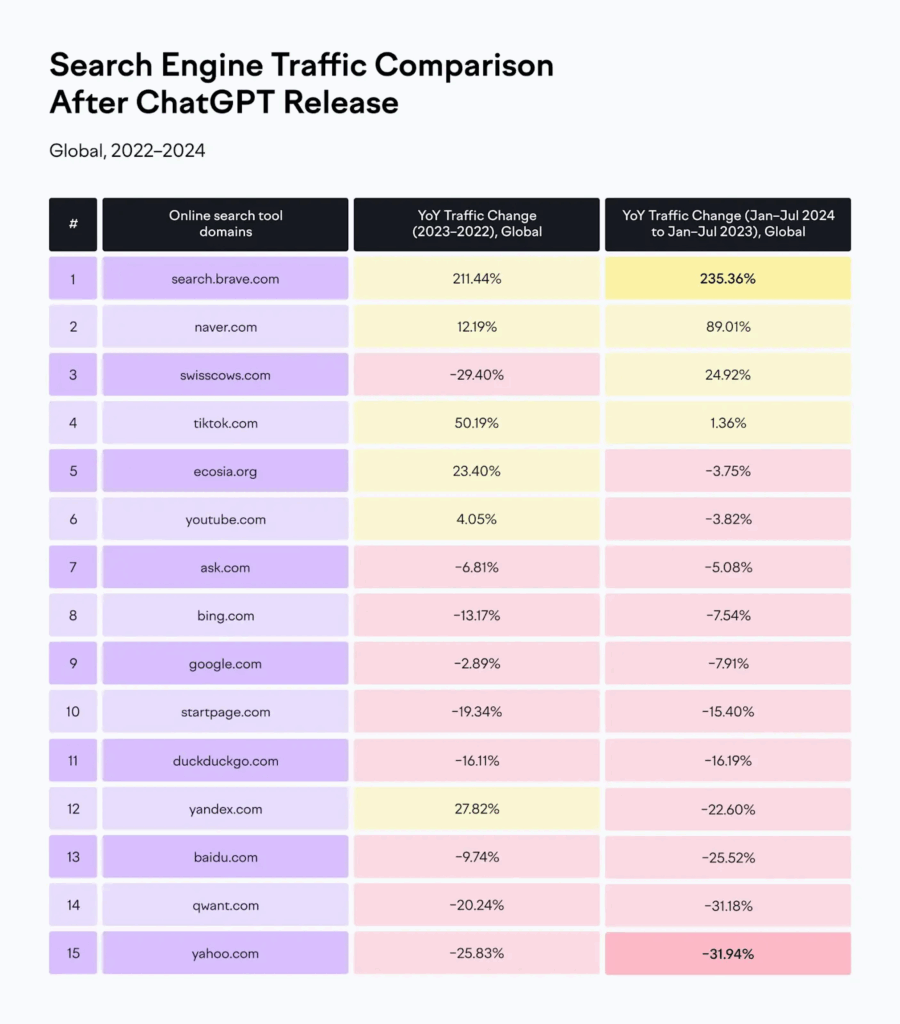
Why Is AEO Important?
On the one hand, this new search paradigm elevates user experience for searchers. Imagine a user asks a complex question wrapped in a conversational speech form – something like, “I lost a lot of weight, how do I tighten loose skin naturally and safely?”
The best type of answer to this question is very nuanced: it would have to consider several conditions. A person wants to find a way to manage loose skin, but it has to be natural, safe, and lead to drastic weight loss.
If you were to Google something like this the old-fashioned way, it would take you scrolling and clicking quite a few sites – all of which would have partially relevant information. You would probably have to sum it up on your own and consider a few controversial opinions.
An AI search tool delivers a clear, concise answer delivered right inside the user’s AI assistant or search engine, with several sources quoted.
In regular SEO, you usually don’t optimize for a search query like this—it’s too particular. Even for a long-tail keyword, it’s just too long-tail. And yet, today, roughly 15% of daily searches are unique, according to Google. That’s between 1.2 and 2.4 billion daily.
AI search tools and AI summaries are an answer to the search patterns that are becoming more nuanced and conditionalized.
Understanding AEO: The Shift from SEO to AI Search
What Is AEO and How It Works
At its core, AEO is the art (and science) of structuring content so AI systems can:
- Find your content quickly.
- Understand it clearly.
- Include it (with citation) in their generated responses.
This includes AI-driven surfaces like ChatGPT replies, Google’s AI Overviews (aka SGE), Perplexity, and voice assistants.
Here’s how it typically plays out:
- A user asks a question (typed or spoken).
- The AI uses retrieval techniques (searching an index of web texts) plus language modeling to craft an answer.
- If your content is well structured and authoritative, the AI might quote or cite it as a source for its response.
In practice, that means crafting strong headlines, using schema markup, breaking content into small answerable chunks, and signaling trust (author credentials, citations).
But that sounds a whole lot like traditional SEO, right?
Yes, and no.
Traditional SEO vs. AEO: Key Differences
Here’s the biggest misconception about AEO: that it somehow replaces SEO.
It doesn’t. In fact, AEO depends on SEO more than ever.
Recent independent testing by Acme.bot proved that ChatGPT’s browsing mode (and other AI engines like Perplexity) don’t scrape random sources; they pull results directly from Google Search, not Bing. And it’s more complicated than that. Paid ChatGPT versions and free logged-in ones do, while only unlogged-in searches most likely pull from OpenAI’s own web search.
According to OpenAI, up to 90% of people use it logged in to their accounts, since it provides access to important featureslike search history—this goes for free accounts, too.
Now you can do the math.
If your page isn’t already ranking well in Google, it’s invisible to most AI models.
In other words, if SEO is the stage, AEO is just the microphone. You still need to rank before you can be quoted.
So, while AEO adds a shiny new acronym, the playbook is familiar:
✅ Build strong SEO foundations
✅ Target commercially valuable, low-competition topics
✅ Structure answers clearly
✅ Publish original insights that force the AI to cite you
If you’re optimizing for Google, you’re already halfway optimized for AI.
AEO just makes you think a little harder about which queries actually matter.
It doesn’t mean, however, that there aren’t any differences SEO professionals need to account for when doing AEO:
| Aspect | Traditional SEO | Answer Engine Optimization (AEO) |
| Goal | Rank high on SERPs and attract clicks | Be cited or recommended inside AI-generated answers |
| Discovery Layer | Google’s organic search results | Still Google (AI assistants pull from top-ranking URLs (Acme.bot proof)) |
| User Path | User clicks through to your site | AI summarizes or cites your content directly |
| Content Style | Keyword-optimized, human-readable | Concise, structured, “answer-ready” (with schema and clear snippets) |
| Metrics | Impressions, CTR, backlinks | Mentions, citations, inclusion in AI summaries |
| Optimization Tools | Rank tracking, backlink analysis | Prompt monitoring, citation tracking, structured data validation |
| Focus Keywords | Informational & commercial intent | Primarily commercial/transactional prompts that require LLM grounding |
Now, about that last line, it’s pretty crucial.
The new equivalent of keyword rank tracking is LLM prompt monitoring. We’ll explain it in the next part.
How AI-powered Answer Engines Work
To really grasp how AI answer engines pick and display your content, you need to understand LLM grounding in the context of search intent and query behavior.
LLM grounding is the process by which a language model (LLM) augments its built-in knowledge (the training data) with real-time or external information. When a user asks something that the LLM can’t confidently answer from memory alone—because it’s too new, too specific, or requires up-to-date data—the model reaches out to web sources (often via Google) to fetch supporting context, citations, or data. That’s when your content stands a chance of being pulled in, quoted, or cited.
Search intent plays a crucial role in whether grounding even triggers. Most queries fall into generic buckets:
- Informational: “How to tie a tie”
- Navigational: “YouTube login”
- Commercial/transactional: “Best project management software 2025”
Because AEO is about being included in AI responses, your target should lean heavily toward commercial/transaction-oriented queries—those that demand fresh, grounded sources. If someone asks a simple factual question (“What is photosynthesis?”), the LLM probably already “knows” it and won’t bother to fetch external content.
To understand how tight competition is, check out this striking stat: 15% of all Google searches are driven by just 148 keywords, according to SearchEngineLand. That shows how heavily search volume is concentrated in a small set of queries, and how hard it is to break in. According to the same source, this is how search intent distribution is today:
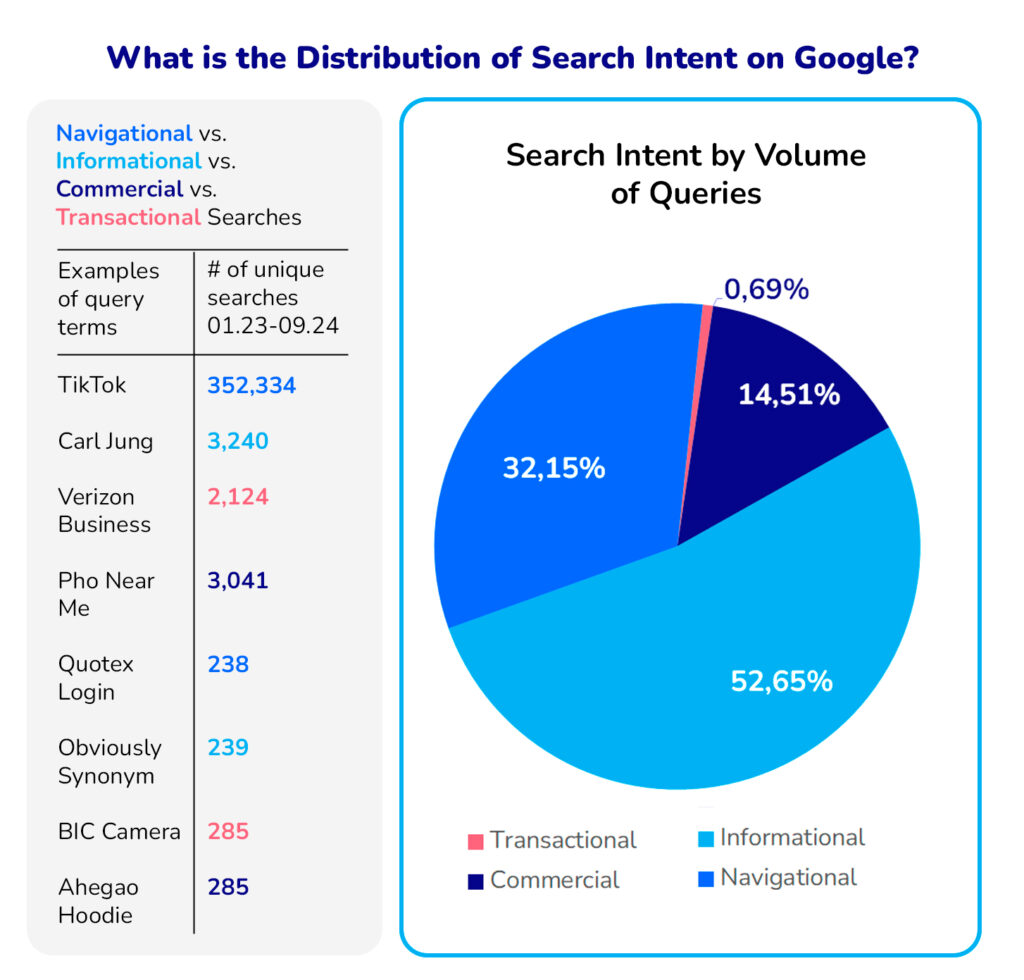
Instead of obsessing over whether you rank for “What is X,” you should be checking which prompts make AI tools pull your content. Because not all prompts are worth chasing.
- Irrelevant prompt example: “What is local SEO?” ChatGPT already knows this from its training data. No citations + no brand mentions = no visibility for you.
- Relevant prompt example: “What are the best AI tools to use when you need to apply High-Context vs Low-Context cultural communication theory when localizing SEO content?” Now we’re talking. That’s a niche, commercial, grounded query where the AI needs to fetch real-world data.
Grounding happens when the model can’t confidently answer using its training data, so it must go to the web—and that usually means Google.
In short:
- You need to aim for queries that force grounding (i.e. that the model can’t just answer from memory).
- You should map those queries to commercial intent, because that’s where brand, tools, and recommendations live, even though their share is small.
- You should also consider Informational queries that require grounding as a way to increase your visibility.
- And you must understand that the query landscape is highly concentrated, so you’ll be competing intensely for small slices of the demand curve.
Generative AI and Retrieval-Augmented Generation (RAG)
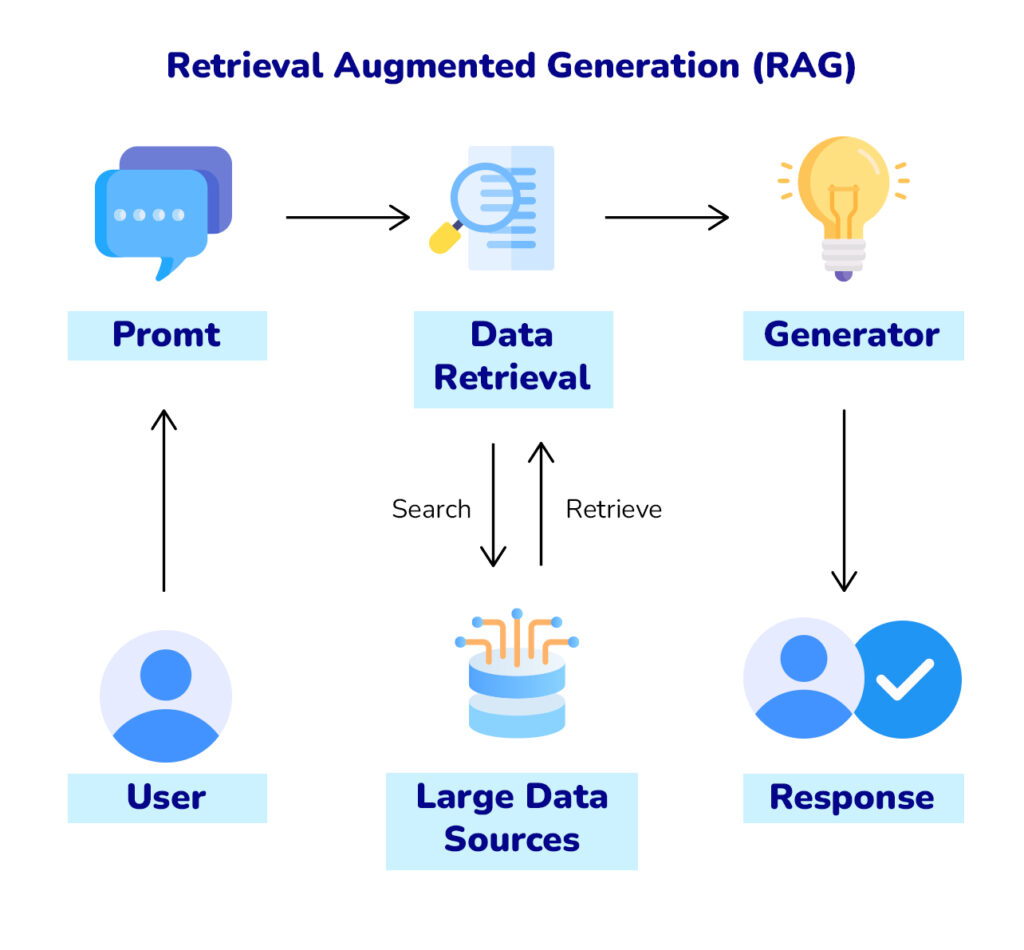
Aside from the rules by which answer engines and AI search tools select content, you should also know how it’s compiled into a conversational answer and which content from your page gets to be quoted (often verbatim).
A modern answer engine doesn’t just generate text from scratch, it combines two complementary capabilities:
- Retrieval: The system searches a corpus (web pages, proprietary databases, knowledge graphs) for relevant text or data.
- Augmentation (or fusion): The model uses retrieved content to ground its generation—i.e. to ensure the answer is factually accurate, cite sources, and avoid hallucinations.
That hybrid approach is called Retrieval-Augmented Generation (RAG) and has one big advantage. The AI can produce fluent, humanlike replies and anchor them in real-world content that you control (if it’s optimized).
For AEO, RAG is the mechanism that gives your content a shot at AI visibility. If your page is in the retrieval index (and well structured), it might be selected and excerpted by the AI.
The Role of LLMs in Answer Generation
Once content is retrieved, an LLM processes it, reasons over it, and generates the final answer. Key LLM actions include:
- Summarizing/Paraphrase: Condense or reword multiple retrieved bits so the answer is clean and readable.
- Ranking/Filtering: Decide which snippets or sources are most relevant or authoritative.
- Citating & Attributing: Insert useful source links or references (if the prompt or platform supports showing provenance).
- Query understanding/Disambiguation: Expand or reformulate ambiguous user queries before retrieving relevant documents.
In short, the LLM is the “brains” combining what it knows (its training) with what it fetches (retrieval). This blend is how a user asking “Which AI answer engines or AI agents should I use for academic research and multi-level analysis?” gets a crisp, actionable answer that might point to your marketed AI agent.
AI Models Used in Answer Engines
(And why it matters for your AEO strategy)
Here are a few of the major models and platforms pushing the answer-engine space—and what each implies for your visibility:
- ChatGPT / GPT-4 / GPT-5: Often used by chatbot interfaces and as a backbone for third-party apps. When set to “web mode,” it relies on Google Search (per evidence) to fetch up-to-date info.
- Google Gemini / AI Overviews: Google’s own AI layer that summarizes content at the top of search results. Getting cited here means being one of the top-retrieved sources in Google.
- Claude (Anthropic): Another AI model often used in chat assistants or enterprise tools that value safety and sourcing.
- Others: Models from Perplexity, Bing Chat / Copilot, Llama derivatives, etc.
Because many of these systems lean on Google or Google-derived indexes for retrieval, your SEO work still underpins your potential for AI visibility.
AEO Strategies to Improve AI Visibility
Now that we’ve basically covered the theory, let’s talk execution. These are the core strategies that work for Answer Engine Optimization (AEO). They’re derived from what delivers results in featured snippets, generative AI surfaces, and AI-driven search platforms.
1. Focus on User Intent and Question-Based Queries That Require LLM Grounding
AI answer engines are built to respond to questions, and not keywords. While the majority of Google searches, according to Semrush, is 3–4 words, when using AI tools, people tend to ask detailed questions more often.
That means your content has to map tightly to search intent and especially to queries that require AI to fetch information from the web.
Here’s what to prioritize:
- Commercial and investigative intent: “Best,” “vs,” “for [industry]”, “alternatives,” “top tools.”
- Emerging or evolving topics where the AI can’t rely solely on its training data (e.g., new SaaS trends, algorithm updates, niche industries).
- Avoid purely definitional queries like “What is onboarding?” AI already “knows” that answer internally, and there’s no room for your brand to surface.
Pro tip: Use question modifiers (“how,” “which,” “when,” “why”) in your headings and meta titles. They increase both the likelihood of retrieval and potential for featured snippets.
2. Write Concise, Direct, Contextual Answers (40–80 Words)
Brevity is the soul of wit, and this quote from Hamlet should be your motto when creating content you want to get picked by AI search features. Google’s AI Overviews feature tends to favor short but concise content modules. Your content should be scannable and self-contained.
✅ Lead with the answer, then expand.
✅ Keep definitions and step-by-step instructions to 40–80 words.
✅ Use bullet lists, numbered points, and short paragraphs.
Example:
Question: What is link velocity in SEO?
Answer: Link velocity is the rate at which a website gains new backlinks over time. A consistent, natural link velocity signals authority and growth to search engines, while sudden spikes can look manipulative and trigger algorithmic scrutiny.
That format feeds both search snippets and AI engines equally well.
3. Optimize for Schema, Entities, and Structured Data
Search engines (and by extension, AI answer engines) rely on structured signals to interpret context. Schema markup helps your content talk to machines.
- Use FAQ schema for Q&A pages.
- Mark up articles, how-to guides, reviews, and products with relevant structured data.
- Clearly define entities (brands, people, places, categories) using consistent names and internal linking.
Structured data doesn’t just help Google understand your page, it helps AI models ground your information accurately, making you a more “trustworthy” retrieval source.
4. Build E-E-A-T and Offsite Authority
Reputation has just as much weight in AEO as it has in SEO, if not more. When selecting a source, AI search tools and features tend to look for a so-called trust consensus: if your data is trusted and quoted across various other sources, it has a better chance of being selected as a source.
- Experience & Expertise: Feature bylines, author bios, and real-world credentials.
- Authority: Earn quality backlinks and brand mentions from credible industry sites.
- Trust: Maintain consistent contact info, HTTPS, and transparent editorial policies.
Backlinks remain the single strongest off-site signal that helps your content rise in both traditional SEO and AI retrieval. When the AI is unsure which source to trust, authority acts as the tie-breaker.
And yes, this is where a platform like Serpzilla comes in. Building context-rich, relevant backlinks still amplifies visibility across both search and generative interfaces.
5. Improve Visibility in Featured Snippets, AI Overviews, and Knowledge Panels
Think of featured snippets as training data feeders for AI. If you own the snippet, you’re statistically more likely to be referenced in AI Overviews or chat results.
Steps to improve:
- Structure your pages with question-based H2s and concise answers directly below.
- Include definitions, comparisons, and lists — all snippet-friendly formats.
- Use descriptive alt text and metadata to reinforce context.
Appearing in a knowledge panel or featured snippet increases your odds of being selected for AI visibility—especially since AI models often prioritize Google-validated sources first.
6. Keep Content Fresh — It’s Still the Price of Entry
Some principles never change. According to various experts, the freshness of your content is the key factor that influences your chances of being quoted by AI search tools and answer engines.
AI engines weigh recency as a key quality signal.
- Content updated quarterly is 3x more likely to earn AI citations.
- For commercial queries, 60% of citations go to content updated within the last 6 months.
- In fast-moving industries like SaaS or Finance, visibility drops sharply after 3 months.
- Even traditionally “evergreen” sectors are seeing faster decay cycles as competition for retrieval grows.
Tools and Platforms for AEO
If you’re wondering which is the best Answer Engine Optimization tool, there really is no single “AEO button.” You combine traditional SEO tools, structured-data checkers, and AI analytics platforms to see where your content stands in the new search ecosystem. If you want to explore the topic of tools in more detail, we have a dedicated article about it.
Here are some tools that can help you level up your AI visibility:
🧠 Semrush AI
Semrush has quietly turned into one of the most versatile AEO allies. Its AI Writing Assistant helps produce concise, search-intent-aligned content, while its Position Tracking and SERP Features reports show whether your pages appear in featured snippets, which is considered to be a key entry point for AI Overviews. You can also monitor zero-click trends and schema performance.
❓AlsoAsked
If AEO starts with user intent, AlsoAsked is a goldmine. It maps real question networks from Google’s “People Also Ask” data, revealing how users phrase questions and which ones trigger featured answers. Perfect for identifying question-based queries that are likely to activate retrieval in AI engines.
💬 ChatGPT Plugins / Web Mode
For testing how AI models reference content, ChatGPT itself is a surprisingly useful diagnostic tool. In web browsing mode, GPT-4 pulls directly from Google search results (confirmed by Acme.bott). By prompting it with your target questions, you can see which sources it cites and whether your domain appears among them.
🧩 Other Tools Worth Mentioning
- Google Search Console – Still the best way to track how Google sees your content.
- Schema.org validators – To ensure your structured data is readable by AI systems.
- Answer Socrates – Surfaces question-based keyword ideas beyond traditional SEO tools.
- Perplexity.ai Analytics (experimental) – Shows referral patterns and citation footprints across AI-powered search.
Checklist: What to Look For in AEO Tools
When choosing tools for Answer Engine Optimization, make sure they help you with:
| Capability | Why It Matters for AEO |
| Question & intent mapping | Helps identify high-value, AI-triggering queries. |
| Structured data validation | Ensures schema correctness for extracting answers. |
| SERP feature tracking | Monitors if you’re earning snippets, panels, or AI Overview spots. |
| Citation & mention tracking | Detects when AI platforms reference your content. |
| Competitor benchmarking | Reveals who’s currently “owning” AI answers in your niche. |
| Freshness & update tracking | Flags decaying pages before they drop out of retrieval cycles. |
Your goal isn’t just to collect more data. Rather, you need to understand how visible your brand is to machines, not just human searchers.
Real-World Use Cases and Success Stories
Let’s ground all this in reality.
Case: Zapier’s Structured-Content Strategy
Automation platform Zapier has mastered AEO without ever calling it that. Its content team built a vast library of “How to connect [Tool A] with [Tool B]” guides, where each is formatted with clear headings, concise 50-word intros, and FAQ schema.
Results:
- Zapier’s “How-to” integration pages dominate featured snippets for over 70% of branded connector queries.
- These same pages are now frequently cited in ChatGPT and Perplexity responses when users ask “How do I connect Slack with Notion?” or similar integration questions.
- According to Ahrefs data, those posts drive over 2 million organic visits monthly, but their zero-click visibility—i.e., where AI references them without a click—is even broader.
This case checks every EEAT box:
- Experience: Guides are written by Zapier’s internal experts.
- Expertise: Each article documents real product workflows.
- Authority: Backlinks from hundreds of SaaS blogs.
- Trust: Transparent authorship and consistent accuracy across pages.
Takeaway: By aligning technical SEO (structured markup and FAQs) with clear, contextual Q&A content, Zapier effectively became the “ground truth” for AI models answering automation-related queries.
Frequently Asked Questions (FAQ)
Is AEO replacing SEO?
No, AEO builds on SEO, it doesn’t replace it.
Answer engines like ChatGPT, Gemini, and Perplexity still rely heavily on Google’s top-ranking pages for their responses. If your site isn’t optimized for traditional search, AI engines won’t find you either. Think of SEO as the foundation and AEO as the layer that makes your content AI-visible and citation-ready.
Can AEO work with traditional SEO?
Absolutely. The two are complementary, not competitive.
Most AEO best practices, such as clarity, structure, schema, and authority already align with Google’s ranking factors. When you optimize for people and for machine readability, you naturally improve both SEO rankings and AI retrieval odds. In fact, the best AEO strategies usually come from strong SEO roots.
Do I need a separate content strategy for AEO?
Not separate, but upgraded.
You don’t need to throw out your content calendar, but you do need to audit it through an AI lens. Ask:
- Does this piece answer a clear question in 40–80 words?
- Is it written for current commercial intent (not just definitions)?
- Is it marked up with schema and updated regularly?
That’s how you retrofit your SEO strategy into an AEO-ready one without doubling your workload.
How do I train my team for AEO?
Start with awareness, then workflow:
- Educate your writers on how answer engines retrieve and summarize.
- Train them to structure pages with question-based headings and concise answers.
- Involve SEO specialists in schema, metadata, and freshness tracking.
- Monitor AI visibility. Test how your content appears in ChatGPT, Gemini, or Perplexity queries.
Once teams see how AI picks answers, they naturally start writing in AEO-friendly formats.
Is AEO only for large enterprises?
Not at all. In fact, smaller brands can win faster because they can adapt more quickly. AI answer engines reward precision, not scale. They also often pull from user-generated content, such as Reddit threads. A small site with clear, updated, structured answers can outperform big players that publish bloated, outdated content.



